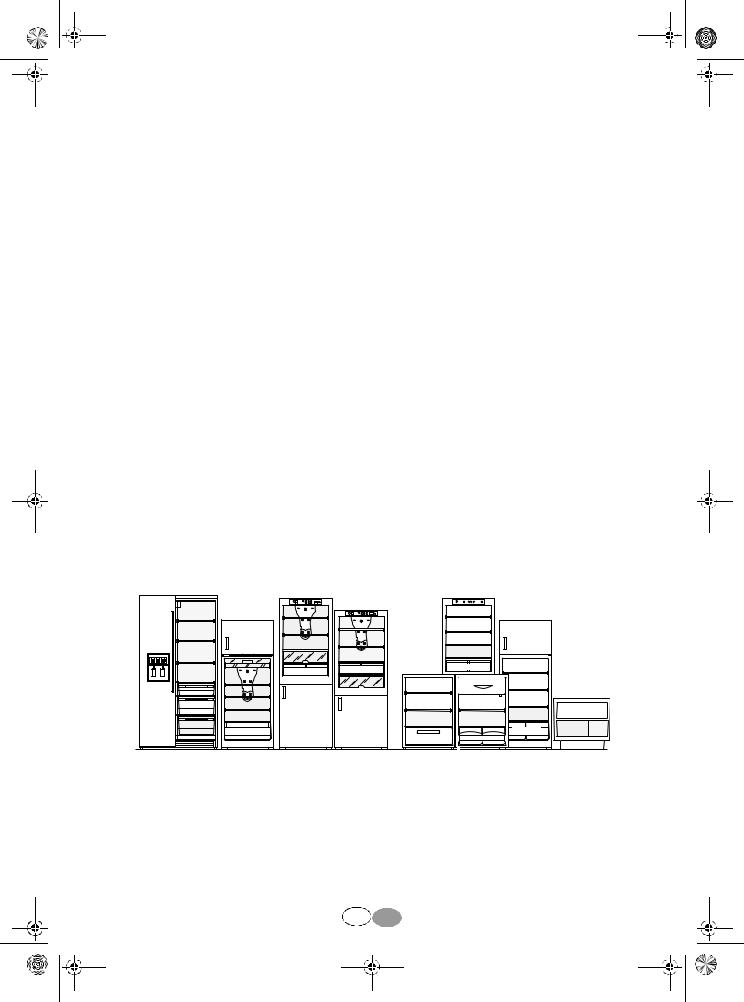HOTPOINT/ARISTON T 16 A1 D/HA, T 16 A1 D/HA.1, T 16 A1 D S/HA, XBZ 800 AE NF/HA, T 16 A1 D/HA.2 Manual [EN]

10200331GB.fm Page 1 Wednesday, July 18, 2007 5:24 PM
TEMPERATURE CONTROL AND OTHER USEFUL TIPS
COLDEST ZONE INSIDE THE REFRIGERATOR
The symbol at the side indicates the coldest zone in the refrigerator.
The coldest zone usually goes from the glass shelf of the crisper drawer at the bottom of the refrigerator to the symbol or rack positioned at the same height.
To maintain the temperature in this zone, be careful not to change the position of the rack.
The coldest zone symbol is not indicated in refrigerators with forced air system (No-Frost), as the temperature is even throughout the entire refrigerator.
TEMPERATURE INDICATOR
For optimum temperature adjustment, the refrigerator is provided with a temperature indicator to allow you to control the average temperature in the coldest zone.
IMPORTANT: The indicator is designed to operate with this refrigerator only.
Do not use it with any other refrigerator (the coldest zone is not the same) or for any other use.
If the refrigerator is provided with a storage compartment, the temperature indicator is located inside the compartment.
CHECKING THE TEMPERATURE IN THE COLDEST ZONE
•After the appliance has been switched on for at least 24 hours, you can carry out regular checks to ensure the temperature in the coldest zone is correct and, if necessary, adjust the thermostat as indicated in the user instructions (chapter “temperature adjustment”).
The internal temperature of the refrigerator depends on various factors such as the ambient temperature of the room, the amount of food stored and how often the door is opened. These factors should be taken into account when setting the appliance.
OK
Correct setting |
Temperature not |
|
optimal, adjust the |
|
thermostat |
To maintain the required temperature inside the appliance, and to preserve your food better, check that the indicator shows the message OK. If the message OK does not appear, this means that the desired temperature has not been reached; in this case, adjust the thermostat setting and wait for 12 hours before checking the indicator again.
When fresh food has been introduced or the door has been left open for some time, it is normal for the message OK on the indicator to fade.
F GB

10200331GB.fm Page 2 Wednesday, July 18, 2007 5:24 PM
COMPLIANCE WITH FOOD HYGIENE REGULATIONS
•Clean the inside of the refrigerator frequently using a mild detergent that does not oxidize metal parts, then rinse with a solution of water and lemon juice or vinegar or any disinfectant product that is suitable for the refrigerator.
•Rinse the interior and dry with a soft cloth.
•Do not use abrasive products.
Remove all packaging before putting food in the refrigerator (for example, cardboard sleeves of yoghurt cartons).
Follow these easy tips to avoid cross contamination and incorrect food storage:
•Wrap food products separately to avoid cross contamination.
•Wash your hands before touching food and many times during the preparation of food, if this means handling various products consecutively, and of course afterwards, before starting to eat, in accordance with sanitary regulations.
•Do not use cooking utensils again (wooden spoon, chopping board) if they have not been washed after use.
•Wait for cooked food to cool completely before storing (e.g.: soup).
•Store liquids in closed containers.
•To prevent temperature increases inside the refrigerator, limit the frequency of door opening and in any case do not leave it open for any longer than is strictly necessary.
•Arrange the food leaving sufficient space around it for the air to circulate.
•Do not place food in direct contact with the rear wall of the refrigerator compartment.
STORING FOODSTUFFS IN THE REFRIGERATOR
• Store each foodstuff in the most appropriate zone:
Temperate zone: Beverages, butter, industrial and homemade sauces, cooked cheeses, fresh fruit and vegetables.
Cool zone: Dairy products, desserts made with milk, fatty foods, fresh cheeses.
Coldest zone: Meat, poultry, fish, cold meats, cooked food, mixed salads, desserts made with eggs or cream, fresh pasta, tart/pie/pizza dough, fresh products and cheeses made with raw milk, ready to use vegetables sold in plastic bags and in general all fresh products that have a best before date associated with a storage temperature below or equal to +4°C.
The tables below are indicative only. For further information on the various parts of the product, please consult the user handbook.
|
|
|
COLDEST |
|
|
|
|
|
|
ZONE |
|
|
|
VEGETABLES |
VEGETABLES |
VEGETABLES |
|
|
|
|
|
|
|
|
|
||
|
|
TEMPERATE |
|
|
|
|
|
|
ZONE |
|
|
|
|
|
|
COOL |
COOL |
|
|
|
VEGETABLES |
|
ZONE |
ZONE |
COLDEST |
TEMPERATE |
|
|
|
COLDEST |
COLDEST |
ZONE |
||
|
|
ZONE |
||||
|
|
|
|
|||
|
|
ZONE |
ZONE |
|
COLDEST |
VEGE- |
VEGETABLES |
|
|
|
VEGETABLES |
||
|
VEGETABLES |
VEGETABLES |
ZONE |
TABLES |
||
|
|
|
|
|
||
NO FROST |
|
|
COLDEST ZONE |
F GB
